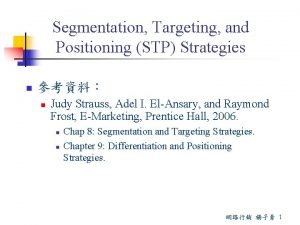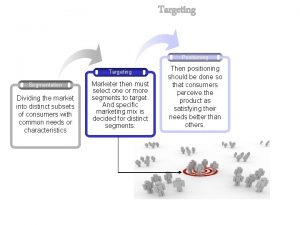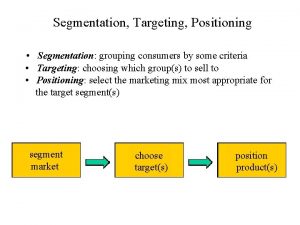Segmentation Targeting Positioning Overview Segmentation Targeting Positioning Why































- Slides: 31

Segmentation, Targeting & Positioning

Overview: Segmentation, Targeting & Positioning Why do this?

Market Segmentation - Principles • Segmentation Variables – Geographic – Demographic – Psychographic – Behavioral – Other (anything!) • No single best way to segment a market. • Often best to combine variables and identify smaller, betterdefined target groups.

Geographic Segmentation • Divide markets into different geographic units. • Examples: – World Region or Country: North America, Western Europe, European Union, Pacific Rim, Mexico, etc. – Country Region: Pacific, Mountain, East Coast, etc. – City or Metro Size: New York, San Francisco – Population Density: rural, suburban, urban – Climate: northern, southern, tropical, semi-tropical

Demographic Segmentation • Use Differences in: – age, gender, family size, family life cycle, income, occupation, education, race, and religion – Most frequently used segmentation variable • Ease of measurement and high availability. – Usually the worst variable to use.

Psychographic Segmentation Psychographic segmentation divides a market into different groups based on social class, lifestyle, or personality characteristics. People in the same demographic classification often have very different lifestyles and personalities.

Behavioral Segmentation • Occasion – Special promotions & labels for holidays. – Special products for special occasions. • Benefits Sought – Different segments desire different benefits from the same products. • Loyalty Status – Nonusers, ex-users, potential users, firsttime users, regular users. • Usage Rate – Light, medium, heavy.

Loyalty Status Segmentation Hard-core Split loyals Shifting loyals Switchers

User & Loyalty Status Segmentation

Geodemographic Segmentation • PRIZM, by Claritas – Organized by ZIP code – Based on Census data – Profiles on a place’s neighborhoods

Claritas’ Prizm

Requirements for Effective Segmentation Segments must be “Lefties” are hard to identify and measure, so few firms target this segment. – Measurable – Accessible – Substantial – Differentiable – Actionable

Evaluating Market Segments • Segment Size and Growth Potential – Sales, profitability and growth rates • Segment Structural Attractiveness – Competition, substitute products, – buyers & supplier power, new entrants (Porter’s Five Forces) • Company Objectives and Resources – Core competencies – “What business do we want to be in? ”

Targeting Segments - Overview

Market Preference Patterns

Undifferentiated (Mass) Marketing – Ignores segmentation opportunities

Differentiated (Segmented) Marketing – Targets several segments and designs separate offers for each. – Coca-Cola (Coke, Sprite, Diet Coke, etc. ) – Procter & Gamble (Tide, Cheer, Gain, Dreft, etc. ) – Toyota (Camry, Corolla, Prius, Scion, etc. )

Niche Marketing – Targets one or a couple small segments – Niches have very specialized interests

Micromarketing • Tailoring products and marketing programs to suit the tastes of specific individuals and/or locations.

Flexible Marketing Offerings • “Naked”/Core solution – Product and service elements that all segment members value • Discretionary options – Some segment members value – Options may carry additional charges

Patterns of Target Market Selection: service Product Market Matrices

Socially Responsible Targeting • Controversies and concerns – Targeting the vulnerable and disadvantaged • Cereal, Cigarettes, Alcohol, Fast-food – The “Catch-22” of Targeting • Psychological Reactance • Failure to target seen as prejudice

Positioning The place a service product occupies in consumers’ minds relative to competing products.

Positioning Example e. Bay’s positioning: No matter what “it” is, you can find “it” on e. Bay!

Positioning Example To (target segment and need) our (brand) is a (concept) that (point-of-difference). “To busy mobile professionals who need to always be in the loop, Blackberry is a wireless connectivity solution that allows you to stay connected to people and resources while on the go more easily and reliably than the competing technologies. ”

Positioning Maps: Luxury SUVs Price vs. Orientation Dimensions

Positioning Strategy • Competitive advantages • Points of Parity • Points of Difference => Differentiation Positioning results from differentiation and competitive advantages. Positioning may change over time.

Sources of Differentiation – Service Product Design – Quality – Additional Services – Image – People (Staff) – Price – Other 6 -28

Choosing the Right Competitive Advantages • The best competitive advantages are… – – – – Important Distinctive Superior Communicable Pre-emptive Affordable (to company and consumer) Profitable Moral: Avoid meaningless differentiation.

Positioning Errors • Under-positioning: – Not positioning strongly enough. • Over-positioning: – Giving buyers too narrow a picture of the product. • Muddled Positioning: – Leaving buyers with a confused image of the product.

Generic Product Positions & Value Propositions…
 Segmentation vs targeting
Segmentation vs targeting Nivea segmentation
Nivea segmentation Market segmentation variable
Market segmentation variable Sony market segmentation, targeting and positioning
Sony market segmentation, targeting and positioning Positioning involves meeting consumers lower performance
Positioning involves meeting consumers lower performance Chosen lesson 7 segment 1
Chosen lesson 7 segment 1 Nokia target market
Nokia target market Southwest airlines
Southwest airlines Global consumer culture positioning example
Global consumer culture positioning example Psychographic segmentation of nivea
Psychographic segmentation of nivea Marketing targeting and positioning
Marketing targeting and positioning Intermarket segmentation examples
Intermarket segmentation examples Market segmentation, targeting and positioning
Market segmentation, targeting and positioning Segmentation bases
Segmentation bases Psychographic segmentation of nivea
Psychographic segmentation of nivea Positioning methods
Positioning methods Segmentation
Segmentation Differentiated undifferentiated and concentrated marketing
Differentiated undifferentiated and concentrated marketing Global market segmentation
Global market segmentation Global segmentation and positioning
Global segmentation and positioning Andreas carlsson bye bye bye
Andreas carlsson bye bye bye Resume jurnal
Resume jurnal Social marketing segmentation
Social marketing segmentation Segmentace targeting positioning
Segmentace targeting positioning Jurnal internasional segmenting, targeting, positioning
Jurnal internasional segmenting, targeting, positioning Targeting segmentation
Targeting segmentation Physician segmentation methodology
Physician segmentation methodology Rural market segmentation and targeting
Rural market segmentation and targeting Three market segmentation strategies
Three market segmentation strategies Don't ask why why why
Don't ask why why why Why-why analysis
Why-why analysis Willie twister
Willie twister

















































